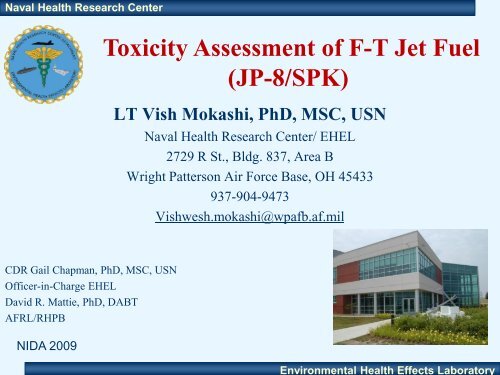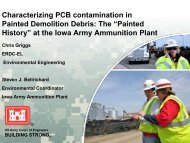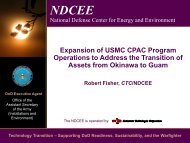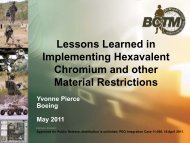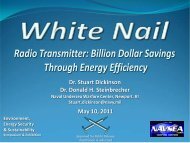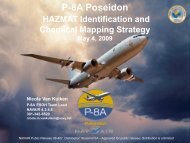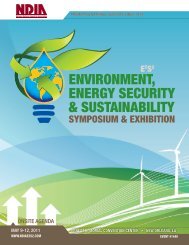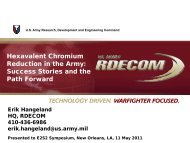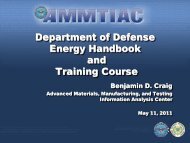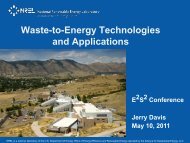Toxicity Assessment of F-T Jet Fuel (JP-8/SPK) - E2S2
Toxicity Assessment of F-T Jet Fuel (JP-8/SPK) - E2S2
Toxicity Assessment of F-T Jet Fuel (JP-8/SPK) - E2S2
Create successful ePaper yourself
Turn your PDF publications into a flip-book with our unique Google optimized e-Paper software.
Naval Health Research CenterEnvironmental Health Effects Laboratory<strong>Toxicity</strong> <strong>Assessment</strong> <strong>of</strong> F-T <strong>Jet</strong> <strong>Fuel</strong>(<strong>JP</strong>-8/<strong>SPK</strong>)LT Vish Mokashi, PhD, MSC, USNNaval Health Research Center/ EHEL2729 R St., Bldg. 837, Area BWright Patterson Air Force Base, OH 45433937-904-9473Vishwesh.mokashi@wpafb.af.milCDR Gail Chapman, PhD, MSC, USNOfficer-in-Charge EHELDavid R. Mattie, PhD, DABTAFRL/RHPBNIDA 2009
Naval Health Research CenterEnvironmental Health Effects LaboratoryThe views expressed are those <strong>of</strong> the presenter and donot reflect the <strong>of</strong>ficial policy or position <strong>of</strong> theDepartment <strong>of</strong> the Navy, Department <strong>of</strong> Defense, orthe U.S. Government. This presentation is approvedfor public release, distribution unlimited. This workwas prepared as part <strong>of</strong> <strong>of</strong>ficial duties. Title 17U.S.C. §105 provides that “Copyright protectionunder this title is not available for any work <strong>of</strong> theUnited States Government.” Title 17 U.S.C. §101defines a U.S. Government work as a work preparedby a military service member or employee <strong>of</strong> the U.S.Government as part <strong>of</strong> that person’s <strong>of</strong>ficial duties.
Naval Health Research Center<strong>Toxicity</strong> <strong>Assessment</strong> <strong>of</strong> F-T <strong>Jet</strong> <strong>Fuel</strong>(<strong>JP</strong>-8/<strong>SPK</strong>)‣Background on major jet fuels‣Background on <strong>JP</strong>-8/<strong>SPK</strong>‣Development <strong>of</strong> the <strong>JP</strong>-8/<strong>SPK</strong> toxicityprogram‣Dermal Irritation‣Genotoxicity‣Inhalation‣Conclusions‣QuestionsEnvironmental Health Effects Laboratory
Naval Health Research CenterBackground‣ DoD consumes ~ 5 B gallons <strong>of</strong> aviation jet fuel per year (USconsumer ~25B)‣ Major <strong>Jet</strong> <strong>Fuel</strong>s:Erica BecvarAFCEE/TDV‣ <strong>Jet</strong>-A‣ Commercial‣ <strong>JP</strong>-4‣ Issued 1951‣ 50/50 kerosene-gasoline blend‣ Contains aliphatic and aromatic hydrocarbons, corrosion inhibitor andanti-static and -icing compounds‣ Phased out by USAF 1976-1996, replaced with <strong>JP</strong>-8‣ <strong>JP</strong>-5‣ US Navy <strong>Fuel</strong>‣ Primarily kerosene‣ Lower volitilityEnvironmental Health Effects Laboratory
Naval Health Research Center‣ Major <strong>Jet</strong> <strong>Fuel</strong>s:‣ <strong>JP</strong>-8 (MIL-DTL-83133)‣ Kerosene-based replacement for <strong>JP</strong>-4Background‣ Mixture <strong>of</strong> aliphatic, aromatic, and substituted naphthalene hydrocarbon compounds‣ Reduced concentrations <strong>of</strong> benzene, n-hexane‣ Contains icing inhibitor, corrosion inhibitors, lubricants, and anti-static agents‣ +100 thermal stability additive can also contain metal deactivators, anti-oxidantsErica BecvarAFCEE/TDVJohn Hinz, Health Risk<strong>Assessment</strong> SupportUSAF School <strong>of</strong> AerospaceMedicineEnvironmental Health Effects Laboratory
Naval Health Research CenterBackground‣ <strong>Jet</strong> fuel toxicity risks traditionally associated with aromatichydrocarbons‣ <strong>JP</strong>-4‣ Conventional petroleum-based military aviation fuels contain ~20%‣ Aromatics and 1-3% naphthalene.‣ toxicity studies have reported skin irritation, defatting, neurotoxicitynephrotoxicity and, in male rats, renal carcinogenicity.‣ In humans, symptoms <strong>of</strong> neurasthenia, psychasthenia, polyneuropathy andsexual dysfunction has been reported in military and civilian workers.Erica BecvarAFCEE/TDVEnvironmental Health Effects Laboratory
Naval Health Research CenterBackground‣ <strong>JP</strong>-8 <strong>Toxicity</strong>‣ Considered slightly toxic‣ Oral Lethal Dose (LD 50 ) > 5.0g/kg (highest tested)‣ Dermal – non-irritating to slightly irritating‣ Repeated and continuous exposure does cause irritation in animals and humans‣ Acute Vapor Inhalation Lethal Concentration (LC 50 ) >3.43 mg/L (highesttested)‣ Acute Aerosol LC 50 >4.39 mg/L (highest tested)‣ Subchronic Inhalation- decreased body weight and renal hydrocarbonnephrothopy in male rats‣ Chronic Inhalation – male rat nephrothapyErica BecvarAFCEE/TDVEnvironmental Health Effects Laboratory
Naval Health Research CenterBackground‣ <strong>JP</strong>-8/<strong>SPK</strong> (aka F-T, S-8…)‣ USAF initiated the “alternative fuels” program in 1999‣ MIL-HDBK-510 Aerospace <strong>Fuel</strong>s Certification‣ Goal <strong>of</strong> system certification and use <strong>of</strong> 50:50 synthetic jet fuel:<strong>JP</strong>-8blend by 2016‣ To be used as a “drop in” fuel (<strong>JP</strong>-8:<strong>JP</strong>-8/<strong>SPK</strong> (50:50))‣ Synthetic jet fuel derived converting natural gas using coalto-liquid(CTL) technology‣ Current synthetic jet fuels (S-8) alkane-rich, have reducedrisk - essentially no aromatics or naphthaleneErica BecvarAFCEE/TDV(2n+1)H 2 +nCOC n H (2n+2) +nH 2 OEnvironmental Health Effects Laboratory
Naval Health Research CenterEnvironmental Health Effects LaboratoryBackground‣ <strong>JP</strong>-8/<strong>SPK</strong> (aka F-T, S-8…)‣ B-52 Certification (Aug 07)‣ C-17 Ground/flight demos and FSE complete‣ F101 engine (B-1B) test at AEDC‣ CFM56 (F108) engine (KC-135) operability testing‣ B-1B Demo flight – late Spr 08‣ Acceleration <strong>of</strong> USAF Comm-Derivative aircraft certificationby FAA Type-Cert (Dec 08?)‣ F-22 certification effort - complete Fall 08‣ F119 engine testing at P&W (May 08)‣ F-16, KC-135, B-2 cert planning in-process
Naval Health Research CenterEnvironmental Health Effects LaboratoryF-T <strong>Jet</strong> <strong>Fuel</strong> <strong>Toxicity</strong><strong>Assessment</strong>‣ Funded by Air Force‣ Goal - Complete initial program by end FY08‣ To ensure that toxicity program addresses all issuesassociated with testing a complex mixture, such as jetfuel, a review panel <strong>of</strong> toxicologists was establishedto discuss the toxicity testing program and provideadvice on testing procedures.
Naval Health Research CenterEnvironmental Health Effects LaboratoryF-T <strong>Jet</strong> <strong>Fuel</strong> <strong>Toxicity</strong><strong>Assessment</strong>‣Panel members:‣David Mattie, Ph.D., DABT, Chair, AFRL/RHPB‣John Hinz, AFIOH/RSRE‣Gunda Reddy, PhD, USACHPPM‣LT Dean Wagner, PhD, MSC, USN, NHRC/EHEL‣David Steup, PhD, Shell Oil and Chairman <strong>of</strong> theToxicology Committee, API‣Errol Zeiger, Ph.D., J.D., Errol Zeiger Consulting,Chapel Hill, NC
Naval Health Research CenterEnvironmental Health Effects LaboratoryF-T <strong>Jet</strong> <strong>Fuel</strong> <strong>Toxicity</strong><strong>Assessment</strong>‣Develop appropriate study design foreach toxicity test proposed:‣In vitro genotoxicity tests‣Dermal irritation test‣Acute inhalation study‣In vivo genotoxicity test in tandem with inhalationrangefinder study‣90-day inhalation toxicity study
Naval Health Research CenterEnvironmental Health Effects LaboratoryF-T <strong>Jet</strong> <strong>Fuel</strong> <strong>Toxicity</strong><strong>Assessment</strong>‣All studies are completed.‣Final analysis and/or report preparation stage.‣Occupational exposure level will be developedby the review panel for the F-T fuel during thelast quarter <strong>of</strong> FY09.
Naval Health Research CenterEnvironmental Health Effects LaboratoryF-T <strong>Jet</strong> <strong>Fuel</strong> <strong>Toxicity</strong><strong>Assessment</strong>‣Dermal Irritation Test‣ Dermal Irritation Test‣ GLP Compliance‣ 100% concentrations <strong>of</strong> either <strong>SPK</strong> or <strong>JP</strong>-8‣ 50/50 mixture <strong>of</strong> <strong>SPK</strong>/<strong>JP</strong>-8‣ Occluded and semi-occluded exposures (each animal its owncontrol)‣ Primary irritation index calculated to assign a descriptive ratingto each test article and mixture
Naval Health Research CenterEnvironmental Health Effects LaboratoryDermal <strong>Toxicity</strong>• <strong>JP</strong>-8 Occluded• Primary Irritation Index = 2.1 Descriptive Rating = Moderately Irritating• <strong>JP</strong>-8 Semi-Occluded• Primary Irritation Index = 1.8 Descriptive Rating = Slightly Irritating• <strong>SPK</strong> Occluded• Primary Irritation Index = 2.3 Descriptive Rating = Moderately Irritating• <strong>SPK</strong> Semi-Occluded• Primary Irritation Index = 0.8 Descriptive Rating = Slightly Irritating• <strong>JP</strong>-8/<strong>SPK</strong> Occluded• Primary Irritation Index = 1.9 Descriptive Rating = Slightly Irritating• <strong>JP</strong>-8/<strong>SPK</strong> Semi-occluded• Primary Irritation Index = 1.5 Descriptive Rating = Slightly Irritating
Naval Health Research CenterEnvironmental Health Effects LaboratoryF-T <strong>Jet</strong> <strong>Fuel</strong> <strong>Toxicity</strong><strong>Assessment</strong>In vitro genotoxicity testsPerformed by Eur<strong>of</strong>ins/ Product Safety LabsGLP Compliance
Naval Health Research CenterEnvironmental Health Effects LaboratoryF-T <strong>Jet</strong> <strong>Fuel</strong> <strong>Toxicity</strong><strong>Assessment</strong>‣Chromosomal Aberration (CA) Test‣ Establish potential for fuel to induce chromosomalaberrations in human lymphocytes with and withoutactivation.‣ Conclusion‣ Chromosomal aberrations were not induced by the fuel‣ <strong>JP</strong>8/<strong>SPK</strong> is considered to be non-clastogenic
Naval Health Research CenterEnvironmental Health Effects LaboratoryF-T <strong>Jet</strong> <strong>Fuel</strong> <strong>Toxicity</strong><strong>Assessment</strong>‣Reverse Mutation Assay (Ames Test)‣ Establish potential for fuel to induce gene mutations‣ Detect point mutations in Salmonella typhimurium‣ Histidine reversion system His - His +
Naval Health Research CenterEnvironmental Health Effects LaboratoryF-T <strong>Jet</strong> <strong>Fuel</strong> <strong>Toxicity</strong><strong>Assessment</strong>‣Reverse Mutation Assay (Ames Test)‣ Preliminary Results‣ No toxic effects in any <strong>of</strong> five tester strains‣ No relevant increase in revertants‣ F-T jet fuel did not cause base pair or frame shiftgenetic mutations in any <strong>of</strong> the tester strains‣Conclusion‣ F-T jet fuel is considered to be non–mutagenic inthis bacterial reverse mutation assay
Naval Health Research CenterEnvironmental Health Effects LaboratoryInhalation studiesF-T <strong>Jet</strong> <strong>Fuel</strong> <strong>Toxicity</strong><strong>Assessment</strong>
Naval Health Research CenterEnvironmental Health Effects LaboratoryF-T <strong>Jet</strong> <strong>Fuel</strong> <strong>Toxicity</strong><strong>Assessment</strong>‣Acute Inhalation Study‣ Completed:‣4 hour exposure‣2000 mg/m 3 dose‣5 males/5 females‣No clinical symptoms observed
Naval Health Research CenterEnvironmental Health Effects LaboratoryF-T <strong>Fuel</strong> <strong>Toxicity</strong>2-Week Study‣ 2-week - Histological findings in:‣ lung: Inflammatory foci evident in highestdoses‣ Olfactory epithelia: degeneration in highestdoses‣ Kidney: hyaline droplet accumulation in allmales exposed‣ Liver: Panlobular hepatocyte changes in allmales exposed and females exposed to thehighest concentration
Naval Health Research CenterEnvironmental Health Effects LaboratoryF-T <strong>Jet</strong> <strong>Fuel</strong> <strong>Toxicity</strong><strong>Assessment</strong>‣90-day Inhalation Study‣Study design based on:‣U.S. Environmental Protection Agency (U.S. EPA)Harmonized Test Guideline developed by the Office <strong>of</strong>Prevention, Pesticides and Toxic Substances (OPPTS)870.3465 90-Day Inhalation <strong>Toxicity</strong> and‣Organization for Economic Cooperation and Development(OECD) guideline 413, Subchronic Inhalation <strong>Toxicity</strong>:‣90-day Study‣U.S. EPA Health Effects Test Guideline OPPTS 870.6200Neurotoxicity Screening Battery.
Naval Health Research CenterEnvironmental Health Effects LaboratoryF-T <strong>Jet</strong> <strong>Fuel</strong> <strong>Toxicity</strong><strong>Assessment</strong>‣90-day Inhalation Study‣ Started April 28‣Route, Duration and Frequency <strong>of</strong> Administration‣Test substance will be administered as aerosol/vaporcombination for 6 h/d, 5 d/w for 13 w‣Exposure Levels‣Animals will be exposed to three concentrations, high,intermediate and low, with a control group (0 mg/mm 3 ).‣2000 mg/m 3 , 700 mg/m 3 and 200 mg/m 3
Naval Health Research CenterEnvironmental Health Effects LaboratoryF-T <strong>Jet</strong> <strong>Fuel</strong> <strong>Toxicity</strong><strong>Assessment</strong>‣90-day Inhalation Study‣Observations‣Animals will be observed before and after exposures forovert signs <strong>of</strong> toxicity‣Tissues and organs will be examined for gross pathology‣Blood will be collected for clinical pathology‣Tissues collected for histopathology including:‣Nasal airways, trachea, larynx, lungs, liver, kidney, spleen,adrenals, heart and others
Naval Health Research CenterEnvironmental Health Effects LaboratoryF-T <strong>Jet</strong> <strong>Fuel</strong> <strong>Toxicity</strong><strong>Assessment</strong>‣90-day Inhalation Study‣Motor Activity and Functional Observational Battery‣To assess the neurobehavioral effects‣Sperm Morphology and Vaginal Cytology Examinations‣Sperm will be stained and examined for percentage <strong>of</strong>abnormal sperm‣Alterations in the estrous cycle will be assessed byexamination cytology from vaginal smears
Naval Health Research CenterF-T <strong>Jet</strong> <strong>Fuel</strong> <strong>Toxicity</strong><strong>Assessment</strong>90-day Inhalation StudyGroup Exposure Level Number <strong>of</strong> Animalsmg/m 3 Males FemalesControl Replicate 15 50Control Replicate 2 5 5Low Replicate 15 5200Low Replicate 2 5 5Intermediate Replicate 15 5700Intermediate Replicate 2 5 5High Replicate 15 52000High Replicate 2 5 5Total 40 40Environmental Health Effects Laboratory
Naval Health Research CenterEnvironmental Health Effects Laboratory90-Day Inhalation Study‣Observations‣Animals observed before and after exposuresfor overt signs <strong>of</strong> toxicity‣Tissues and organs examined for grosspathology‣Blood collected for clinical pathology‣Full tissue list collected for histopathology‣Analyzed male rat kidneys for alpha 2microglobulin
Naval Health Research CenterEnvironmental Health Effects Laboratory90-Day Inhalation StudyMean Exposure LevelsGroup Exposure Level Number <strong>of</strong> AnimalsMalesFemalesControl 0.02 ± 0.10 10 10Low 200.1 ± 5.0 10 10Intermediate 698.6 ± 16.8 10 10High 1988.4 ± 48.1 10 10
Naval Health Research CenterEnvironmental Health Effects LaboratoryBody Weights
Naval Health Research CenterEnvironmental Health Effects LaboratoryFood Consumption
Naval Health Research CenterEnvironmental Health Effects LaboratoryHematology• There were no biologically significant ortoxicologically significant changes inhematology or clinical chemistry values seenin any <strong>of</strong> the groups.
Naval Health Research CenterEnvironmental Health Effects LaboratoryNasal Histopathology
Naval Health Research CenterEnvironmental Health Effects LaboratoryLung Histopathology
Naval Health Research CenterEnvironmental Health Effects LaboratoryKidney Histopathology
Naval Health Research CenterEnvironmental Health Effects LaboratoryAlpha 2 MicroglobulinGroup Exposure Level α 2μ - globulin Concentration (µg/mg)MalesFemalesControl 0.02 ± 0.10 49.43 ± 20.87 0.16 ± 0.05Low 200.1 ± 5.0 49.72 ± 20.57 N/AIntermediate 698.6 ± 16.8 50.90 ± 13.72 N/AHigh 1988.4 ± 48.1 35.65 ± 8.49 0.15 ± 0.01
Naval Health Research CenterEnvironmental Health Effects LaboratoryF-T <strong>Jet</strong> <strong>Fuel</strong> <strong>Toxicity</strong><strong>Assessment</strong>Conclusions:‣Dermal - animal protocol approved, start date TBD‣Genotox - No genetic mutations observed in vitro‣Inhalation‣Acute - No clinical symptoms observed‣2-week - Histological findings in:‣lung: Inflammatory foci evident in highest doses‣Olfactory epithelia: degeneration in highest doses‣Kidney: hyaline droplet accumulation in all males exposed‣Liver: Panlobular hepatocyte changes in all males exposedand females exposed to the highest concentration‣90-day- Started 28 Apr 08
Naval Health Research CenterEnvironmental Health Effects LaboratoryF-T <strong>Jet</strong> <strong>Fuel</strong> <strong>Toxicity</strong><strong>Assessment</strong>Next:‣Develop HHA‣Sensory Irritation Assay‣Genetic Biomarkers <strong>of</strong> Exposure‣Immunotoxicity Screen
Naval Health Research CenterEnvironmental Health Effects LaboratoryQuestions?


